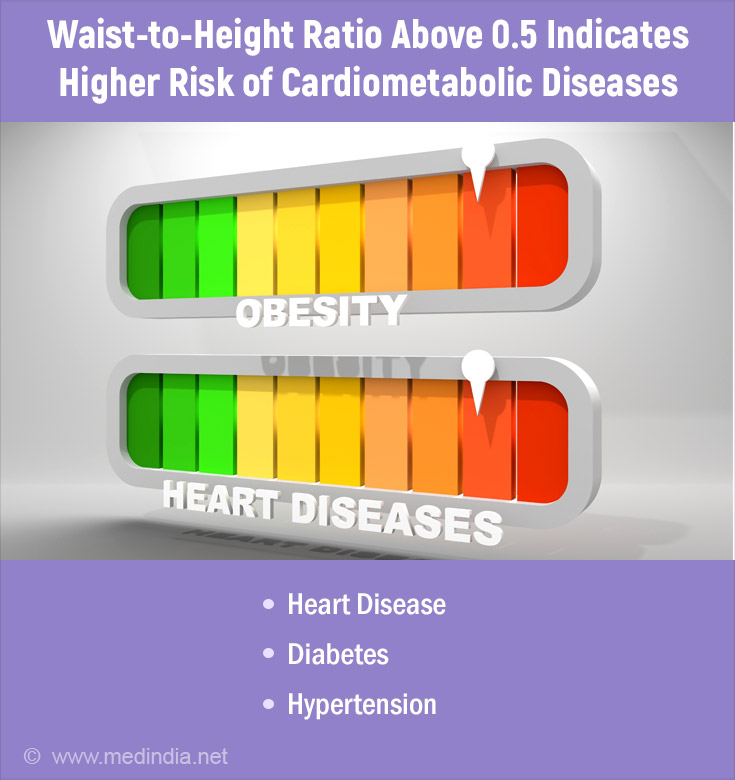- Waist-to-height ratio detects fat obesity in children and adolescents significantly better than BMI - (https://www.bristol.ac.uk/news/2024/march/waist-to-height-ratio.html)
About
Obesity is a global health challenge, with its diagnosis and management being critical to preventing a myriad of related health issues. Traditionally, Body Mass Index (BMI) has been the standard metric for assessing obesity. However, recent developments in obesity research have led to the emergence of the waist-to-height ratio as a more precise indicator of obesity-related health risks. This diagnostic framework provides a more accurate assessment of the health hazards associated with abdominal fat buildup(1✔ ✔Trusted Source
Waist-to-height ratio detects fat obesity in children and adolescents significantly better than BMI
Go to source).
Did You Know?
The waist-to-height ratio can predict the risk of heart disease and diabetes more accurately than BMI. A ratio above 0.5 is a key indicator of health risks related to abdominal fat.Waist-to-Height Ratio Can Predict Cardiometabolic Risk
The new diagnostic approach emphasizes the waist-to-height ratio as a key indicator of health risks associated with obesity. This methodology challenges the traditional BMI-based assessments by providing a more comprehensive picture of obesity-related health concerns. The framework integrates both BMI? and waist-to-height ratio, highlighting the importance of a waist-to-height ratio greater than 0.5 as a marker for increased cardiometabolic risk.
While BMI provides a general measure of obesity, it fails to account for the distribution of fat in the body, particularly abdominal fat. Abdominal fat, or visceral fat, is closely linked to serious health conditions such as heart disease, diabetes, and hypertension. By incorporating the waist-to-height ratio, this new approach aims to address the limitations of BMI and improve the accuracy of obesity diagnosis.
Why is Waist-to-Height Ratio a Better Predictor of Health Issues?
The scientific rationale behind emphasizing the waist-to-height ratio lies in its ability to more accurately predict health issues related to fat distribution. Researchers underline that abdominal fat distribution is a better predictor of health problems than BMI alone. This is because BMI does not distinguish between muscle and fat, nor does it account for where fat is stored in the body. As a result, individuals with significant abdominal fat but a low BMI may be overlooked by current diagnostic guidelines.
The waist-to-height ratio, on the other hand, directly measures the proportion of waist circumference to height, providing a clear indication of central obesity. Studies have shown that a waist-to-height ratio greater than 0.5 is strongly associated with an increased risk of cardiometabolic diseases. This makes it a superior marker for identifying individuals at risk of health issues related to abdominal fat.

How Waist-to-Height Ratio Affects Diagnosis and Treatment of Cardiometabolic Disorders
Incorporating the waist-to-height ratio into diagnostic criteria for obesity is intended to alleviate the constraints of relying solely on BMI. This new framework aims to improve early identification and treatment methods for individuals at risk of cardiometabolic disorders caused by abdominal fat buildup. By broadening the criteria beyond BMI, healthcare professionals can better identify those at risk but do not meet traditional BMI thresholds for obesity.
"The choice of introducing the waist-to-height ratio, instead of waist circumference, in the diagnostic process is due to its superiority as a cardiometabolic disease risk marker," suggested the authors. They claim that this change will aid in identifying individuals who are currently underserved by BMI-centric standards.
Moreover, the waist-to-height ratio allows for a more personalized approach to obesity management. By identifying individuals with central obesity, healthcare providers can tailor treatment plans to address specific health risks associated with abdominal fat. This may include targeted lifestyle interventions, dietary modifications, and specific medical treatments aimed at reducing visceral fat.
The deployment of this new approach has the potential to revolutionize obesity management. By focusing on the waist-to-height ratio, healthcare professionals can better customize therapies to reduce the health risks associated with obesity-related abdominal fat. This shift in focus from BMI to waist-to-height ratio represents a significant advancement in the understanding and treatment of obesity.
In conclusion, the waist-to-height ratio provides a more accurate and reliable measure of obesity-related health risks than BMI alone. The new diagnostic framework highlights the importance of considering fat distribution, particularly abdominal fat, in the assessment and management of obesity. By integrating the waist-to-height ratio into clinical practice, healthcare providers can improve the early detection of cardiometabolic risks and deliver more effective, personalized treatments for individuals struggling with obesity. This approach marks a pivotal step forward in the ongoing fight against obesity and its related health complications.











